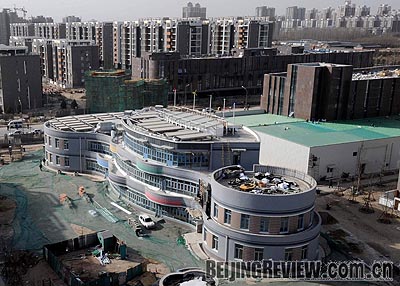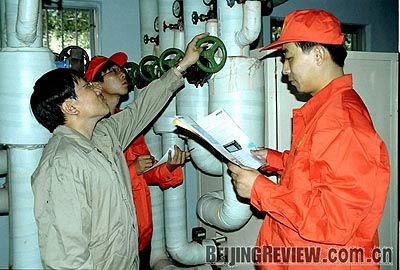|
With no air conditioning or indoor heating, families in southeast Beijing's Fangzhuang neighborhood still enjoy refreshing warm air all year round. The secret is in the pump technology. Heat pumps cool the homes in summer and warm them in winter just like a central air-conditioning system.
 |
|
GREEN POWER: During the Olympic Games, green technologies such as heat pumps cut carbon dioxide emissions in the Olympic Village by 8,000 tons (LUO XIAOGUANG) |
 |
|
A GEOTHERMAL HEAT PUMP: Technicians inspect a geothermal heat pump. The equipment is far more cost-efficient than other heating or cooling equipment (ZHOU SHENGHUA) | Traditionally, people heat their rooms by burning coal, oil or gas or using electricity. Coal dominates China's energy portfolio. Although alternative energies are increasingly being used, China's energy structure will not change for a long time. Currently, more than 50 percent of China's electricity is generated by coal combustion.
While providing light, warmth and energy, coal also produces many toxic pollutants when burned. In winter, many cities in China are shrouded in air laden with pollutants from coal. Coal-fired boilers and belching chimneys are seen in many neighborhoods.
Fossil fuels like coal not only produce hazardous pollutants, but also emit carbon dioxide, which is considered a major cause of global warming.
To cut pollution and carbon emissions, scientists have been working hard to improve the combustion efficiency of coal. They have designed software and mathematical models to study and control the combustion process.
Advanced heat-pump technology can help keep people warm and lower the demand for dirty fossil fuels. While people are familiar with water pumps, which are widely used in irrigating crops and supplying drinking water, many people do not yet know about the new energy-saving heat-pump technology.
Just as a pump transports water from one place to another, a heat pump transfers heat efficiently from one place to another. It is especially valuable in today's world, where the energy supply is strained and the environment is deteriorating.
Heat pumps do not use combustion as they absorb heat from water, air or ground, and transport and release it at its destination, said Fan Xin, General Manager of Tsinghua Tongfang Artificial Environment Co. Ltd. The company has been engaging in heat pump research and development for quite some time and has completed several demonstration projects.
"Without combustion, no exhaust gas, hence no carbon dioxide, sulphur dioxide or ashes will be emitted," said Fan. "If heat pump systems are used in an area of 5 billion square meters, 40 million tons of coal will be saved in a year, reducing carbon dioxide emission by 80 million tons."
Heat pumps, refrigerators and air conditioners work on similar principles. Refrigerators use liquid refrigerant, usually freon in the early days. The liquid circulates between an evaporator, compressor, freezer and expansion valve. As freon was later found to damage the ozone layer, it was substituted by other refrigerants.
Heal pumps work on an old theory, called the Carnot cycle, said Fan. In 1824, Sadi Carnot, a French engineer put forth the Carnot cycle theory. He conceptualized an ideal cycle between a heater and a cooler. Temperature differences can generate dynamics, while energy can be used to produce temperature differences, according to Carnot. Almost 30 years after Carnot published his paper on the cycle, Lord Kelvin, a British physicist realized the cooling process could be reversed to produce heat. In the following 100 years or so, many scientists and engineers studied heat pumps, though they were not put into commercial use until about 12 years ago.
|
